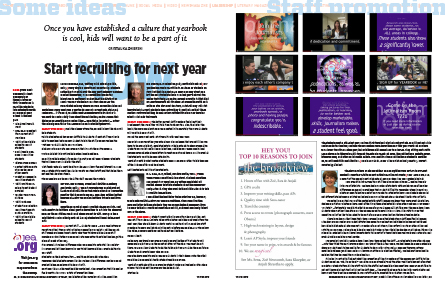Start recruiting for next year
Staff recruitment cannot be an afterthought. It has to be a well-planned priority, not only for the adviser and for editors but also for everyone on staff. Like everything else in student media, it is a team production.
Successful recruitment efforts involve visiting other classes, making personal contact with prospective students, producing fliers and videos and — perhaps most of all — making the journalism lab a place other students want to be.
As for other journalism pedagogical efforts, the best way is to learn from those who have developed successful strategies. Advisers throughout the nation willingly revealed their techniques, participated in a JEA survey that contributed enlightenment and shared materials their students produce as part of a year-round effort to recruit new staff members.
For a link to the winter issue of JEA’s magazine — Communication: Journalism Education Today, CLICK HERE. JEA members receive the magazine as a benefit of their membership.
To see the results of the JEA survey regarding staff recruitment, CLICK HERE
SARAH NICHOLS, MJE, Whitney High School (Rocklin, Calif.) | Every day is a recruitment opportunity. Students notice the staff shirts and the way yearbook staff members conduct themselves, from professionalism during interviews to excitement and pride at the distribution event. Younger students from other classes see the framed photos in my classroom from convention trips and workshops. Every post from a yearbook account on Facebook, Pinterest, Instagram … if it’s good, we look good so people want to be part of it. We work to create a daily buzz about the publication, and we frame that dialogue as something fun and exciting — something important — rather than simply something time-consuming and potentially stressful.
SURVEY RESPONSES | Push the classes’ strengths, especially how this class will help students.
Talk to students and have your staff talk to students. If each staff member is able to convince just one new student to join the staff, you can replace the “retirees” and still add to your numbers.
Find a way to promote your program that impacts the entire campus.
Try to establish links with middle school media advisers.
Recruit in middle school. If you don’t recruit, you will never discover students that will become valuable for the staff.
Visit feeder schools. Work hard to make Journalism 1 fun and interesting. I use my J-I students to work like a junior varsity yearbook staff, and that helps them get excited about yearbook.
The counselors can be your best friends if you use them wisely.
Don’t ever let up. Students reaching students works best. The perception that it is cool or fun is worth a ton. (CF: I’ve read this before.) Try a variety of promotion ideas.
It is critical to have a plan and to be very intentional in recruitment efforts.
Always be thinking about it. In the back of your mind, think of students you come in contact with and how they would be contributing on staff. Then talk with them about it. One-on-one recruiting seems the most effective form for us. Once they can put a face to how they are valued, they are more likely to sign up. Plus, it makes recruiting easy as it goes on throughout the year little by little instead of one big task on your to-do list at one of the busiest times of year.
Start early because guidance counselors can be tough to work later in the year.
CRYSTAL KAZMIERSKI, Arrowhead Christian Academy (Redlands, Calif.) | We get referrals from English and art teachers and invite those students to attend an information meeting that is open to anyone. Somehow getting invited because a teacher recommended them helps to get them there.
Sometimes I send a team to English classes of ninth- and 10th-graders to tell them about yearbook and how to get into the class and some of the cool things we do and places we get to visit. Once you have established a culture that yearbook is cool, students will want to be a part of it.
SURVEY RESPONSES | Current staff — students’ peers — are a much stronger recruitment tool than anything that can come from an adult. I will have each staff member choose two students who they think would be strong staff members and write them a personal note suggesting they take the class (with a piece of candy of course).
Let students promote the program to other students. Ours speak right before enrollment to the upcoming freshmen. Show the product; emphasize the positives about the class.
Use your current staffers to “pledge” or recommend underclassmen. I tell my staff to think about younger students, individuals they know through other programs, who share their same passions and temperaments. These students seem to be the best to carry on the torch.
Build the program so counselors cannot simply “stick” kids in there. I have not made it to that point yet due to the size of the school and being an IB school. I lose my best students after sophomore year.
Have each staff member give you the name of three to five good candidates. Give each person they suggest a personal recruitment letter with an application.
It’s personal. It makes a difference when you speak to potential “journalists” in person and let them know why you think they would be a great addition to your staff.
Students are the best recruiters — and the adviser asking teacher-recommended students personally also makes a big difference. Having a good product is key. People want to be part of it.
Don’t ever let up. Kids reaching kids works best. The perception that it is cool or fun is worth a ton. Try a variety of promotion ideas.
KIM GREEN, MJE Columbus (Ind.) North High School | Our yearbook seems to recruit itself. We have 47 students on staff, but that does not mean we are on easy street. We lost seven talented students from last year’s staff at the end of their first year, and we cannot afford to let that kind of experience walk out the door. After speaking with each of those who chose not to return, I related to my editorial board what I learned: Students leave when they do not believe their ideas matter or when what they do gets redone without the chance of learning what to do to fix their work.
SURVEY RESPONSES | The better current staff members feel about their involvement, the more they will talk it up to classmates. Also, the better the book, the more people who are represented in it accurately, the more students will want to be a part of it.
Pound the pavement early. Start recruiting for next year now.
Never let up on recruiting (my school now drops classes that are not full so we have to be ever-vigilant), send students to middle schools to show prospective students your print and online publications, publicize your successes in local newspapers and school newsletters to reach parents and have a quality product that students want to be associated with.
Be enthusiastic. It’s catching. It takes a while to build that so be patient. Two years, average.
Enlist your students. They are the best recruiters.
Every interaction you have with students on campus recruits students — or deters them. Your current staff and the media it produces are the best promotion for getting the kind of creative journalists you want for the future.
Contacting students personally is a good method.
Start early.
Word of mouth is what works. Students encourage one another to join because of the balance of fun and hard work.
Let the students sell it to other students.
H. L. HALL, MJE, retired, Hendersonville, Tenn. | Yesss! Yesss! Yesss! Recruiting is important. The best recruiters are current staff members. My editors would visit all English classes to talk to students about the newspaper and yearbook. They also went to the middle schools to talk to English classes there.
I found that the best thing that worked for me, however, was to ask English teachers for recommendations. Then I would write a personal letter to those students they recommended and encourage them to come to the informational meeting. Most did, and most eventually joined one of the staffs.
SURVEY RESPONSES | Students want a family away from home, a tribe. Get your staff to make a 4-minute video with photos and video and music from the past year, they should show students working and having fun. Send two staff members to every English class in the spring before course sign-ups. They show the video, answer questions and hand out applications.
Personalize it
Make sure you brand your program and you are the face of it. Students will come and go, but you are the constant driver of the class. You must be out there. You can allow students to do the talking, but you must be there so future students and parents know who you are.
Have teachers speak to and encourage students in their classes who they feel would be strong candidates for student media programs.
Word of mouth about the program by students who are involved and teachers whom I talk to about the program has helped a lot.
The product has to be a draw because of its relevancy and quality. The staff has to have a reputation of fun, family, prestige and success.
Use multiple channels, start early and follow up.
Work with the teachers in feeder schools and in high school classes. If they buy in, it will help. Use your current staffers in your recruiting efforts.
Work a year in advance. Recruit younger.
Seek out the best and pique their interest.
Having teachers recommend students and then sending them an invitation worked well to get my program started. Once we built it, it kept going.
Start early.
To see the results of the JEA survey regarding staff recruitment, CLICK HERE

